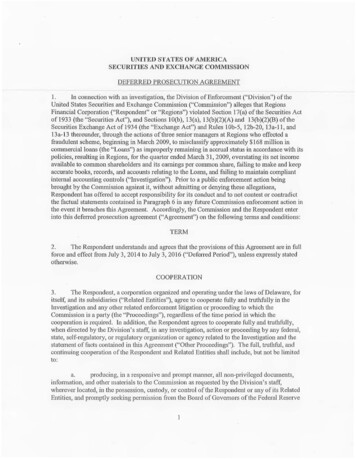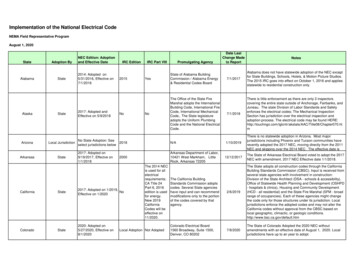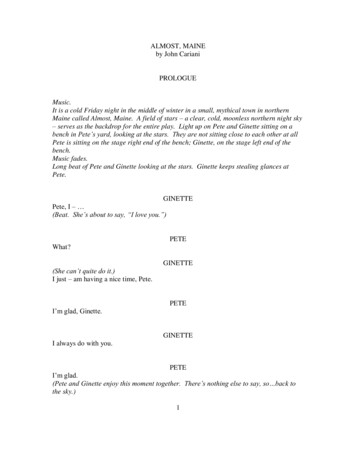
Transcription
the Regionsof MaineMAINEThe Maine BeachesThe most forested state in Americaalso has one of the longestcoastlines and hundreds oflakes and mountains.The birds like the variety.So will you.Long sand beaches andamusements. Notable birds:Piping Plover, Least Tern,Harlequin Duck, and UplandSandpiper.Aroostook CountyGreater Portlandand Casco BayHome of Maine’s largest cityand Scarborough Marsh.Notable birds: Roseate Ternand Sharp-tailed Sparrow.Midcoast RegionExtraordinary state parks,islands, and sailing. Notablebirds: Atlantic Puffin andRoseate Tern.Downeast and AcadiaLand of Acadia National Park,national wildlife refuges andstate parks. Notable birds:Atlantic Puffin, Razorbill, andSpruce Grouse.The Maine HighlandsMaine Lakes andMountainsKennebec &Moose RiverValleysSki country, waterfalls, scenicnature and solitude. Notablebirds: Common Loon,Philadelphia Vireo, andBoreal Chickadee.Downeastand AcadiaKennebec &Moose River ValleysMaine Lakesand MountainsGreat hiking, white-waterrafting and the Old CanadaRoad scenic byway. Notablebirds: Warbler, Gray Jay,Crossbill, and Bicknell’sThrush.The MaineHighlandsSite of Moosehead Lake andMt. Katahdin in Baxter StatePark. Notable birds: SpruceGrouse, and Black-backedWoodpecker.MidcoastRegionGreater Portlandand Casco BayA rich landscape andcultural heritage forgedby the forces of nature.The Maine Beachesw.e.s.Aroostook CountyRich Acadian culture,expansive agriculture andrivers. Notable birds: Threetoed Woodpecker, PineGrossbeak, and Crossbill.
Contents2. Maine Birding Information3. Legend3. The Maine Beaches5. Greater Portland and Casco Bay8. Midcoast Region11. Downeast and Acadia15. Maine Lakes and Mountains18. Kennebec and Moose River Valleys19. The Maine Highlands22. Aroostook County23. Code of Birding Ethics23. Travel Tips24. Birds of Maine Checklist25. Travel ResourcesBirdingmainetrailIt’s no secret that Maine is one of North America’s topbirding destinations. For breeding warblers, borealspecialties, and birds of coastal and offshore waters,Maine offers unmatched opportunities to find some ofthe country’s most sought-after species. Spanning boththe forest transition zone from deciduous to coniferouswoodlands, and the coastal transition zone from sandybeaches and saltmarsh estuaries to rocky shore, Maineprovides a wide range of habitats for birds, many of whichreach their northern or southern range limit here. Thisdiversity is reflected in a state list of regularly occurring birdsthat now numbers over 330 species.Birding in Maine is a year-round activity. Spring migrationis long, with the hardiest species arriving as the snow beginsmelting in early March and continuing well into early Junewith a final northward push of shorebirds. The songs ofmixed sparrow flocks and the distinctive display-flightsounds of American Woodcock in early April are welcomenotes to this eagerly awaited season. Blue-headed Vireos,Hermit Thrushes, Ruby-crowned Kinglets, and other vocalpasserines make their presence known soon thereafter,accompanied by hawks that pour into the state through themonth. Highlighting the spring migration for birders arethe warblers: beginning with the first Palms and Pines inlate April and finishing with the late-arriving Mourningsin late May, the warbler migration is center stage at many ofthe most popular—and most accessible—birding sites aroundthe state. A good morning at one of these sites can tally 22 ormore warbler species. Shorebirds build in number throughMay, peaking during its last week.June and July are alive with breeding activity. Time spenthiking mountain trails and exploring the spruce-fir andmixed woods of the Northern Forest provides opportunitiesto find such target birds as Spruce Grouse, Black-backedWoodpecker, Yellow-bellied Flycatcher, Philadelphia Vireo,Gray Jay, Boreal Chickadee, Bicknell’s Thrush, and a varietyof warblers. The Nelson’s and Saltmarsh Sparrows are latenesters and are reasonably easy to see through July. AtlanticPuffins, Razorbills, and Arctic Terns are also reliable findson offshore islands through the period. When the woodsgo quiet in August, the focus shifts to the exceptionalshorebirding at select locations all along the Maine coast. Attimes thousands of migrating shorebirds of a dozen or morespecies can be found, providing identification challenges forbirders of all abilities.Forest songbirds begin flocking in August, and theirfall migration builds and peaks in September. Offshoreislands and the ends of peninsulas often attract spectacularconcentrations of these migrants, with warblers again oftenstealing the show, and the attendant Sharp-shinned Hawksand Merlins keeping everything moving. Maine’s protractedfall migration period continues well through October intoNovember as waterfowl, grebes, loons, alcids, and a varietyof gulls take up winter residence along the coast. Among the32 waterfowl species that regularly occur in Maine annuallyis the spectacular Harlequin Duck, which now can readily befound at an increasing number of sites through the winter.Although land birds can be scarce during the coldest wintermonths, the possibility of finding a Rough-legged Hawk,Snowy Owl, Northern Shrike, Bohemian Waxwing, or a flockof one of the “northern finches” that irrupt periodically herealways makes birding outings well worthwhile.Rural, extensively forested, studded with thousands of waterbodies and rivers that drain to a deeply indented coastline,Maine invites exploring for birds. Visiting the sites listedin this brochure should provide the traveling birder withmany opportunities to find most of the species that regularlyoccur in the state over the course of a year. These sites areamong the state’s best known and representative birdinglocations. There are many others, however, and a carefullook at detailed maps, coupled with an effort to seek out localknowledge of where to find birds, will also be rewarding.Building public awareness in the value of birding tourism—and being respectful of both private property and the birdsthemselves—helps advance the efforts to conserve our birdlife.
LegendHikingRestroomsMap ATHE MAINE BEACHESmap aHandicapped accessiblePicnic facilities202Fee charged951111MAMJJASND J F O 19Biddeford35SanfordSaco9BiddefordPool6Optimal viewing months99 5AcknowledgmentsKennebunk9A95499Wells19BPHOTO CREDITS: Spruce Grouse photo on cover, Eric Dresser,www.ericdresserphotos.com; Atlantic Puffin on cover, PaulGarrity, www.mainebirding.net; Bay-Breasted Warbler on cover andinside bird images, Garth McElroy,www.featheredfotos.com.Fort FosterFort Foster in Kittery sits on Gerrish Island overlookinga large expanse of ocean and tidal river. This is a goodmigrant trap in spring and fall, and a winter place to look foralcids, sea ducks, and Purple Sandpipers. This is the site ofa fort that protected the Portsmouth Naval Shipyard throughboth World Wars. The park gate is closed from late fall to latespring, but birders may park at the gate and walk in duringthe off-season. May be icy in winter.Kennebunkport4Bob Duchesne conducted the principal research, writingand mapping.1.THE MAINE BEACHESOgunquitdirections:From Route 1 in Kittery, follow 103 east 3.5 miles. Turn right onto Chauncey CreekRoad, follow 0.5 miles, turn right onto Pocahontas Road. Cross the Gerrish IslandBridge, turn right, and follow Pocahontas Road 1.2 miles. A fee is charged in summer.MAMJJASND J F O 231911AYork236103951KitteryPortsmouth1Miles of sand beaches, salt marshes, and tidal estuaries attractmore than 30 species of shorebirds annually. Scatteredheadlands provide good scanning for seabirds. Deciduous forestand fields of the interior are breeding habitat for many speciesat their northern range limit.For more information on The Maine Beaches visitwww.southernmainecoast.com2.Mt. AgamenticusMt. Agamenticus in York is one of Maine’s besthawk‑watching sites in September. Hawks are best seenon southerly breezes in the spring and northwest breezesin autumn. In breeding season, the surrounding woodlandtrails are good for songbirds.directions:From Route 1, turn south onto Clay Hill Road. Drive 3.9 miles, bearing right at aT‑intersection, and continue another 1.6 miles. Drive 0.6 miles to the summit or parkbelow and walk the trails or road.MAMJJASND J F O This guide is abridged from The Official Guide to theMaine Birding Trail, published by Down East Books, 2009.The Official Guide contains hundreds of additional sites,maps, and tips for birding Maine in all seasons. Available atwww.downeastbooks.com 2009 Maine Office of Tourism
3.202M a r g i n a l Way111Marginal Way in Ogunquit is a narrow, paved, mile-longfootpath that hugs the rocky shoreline. It is extraordinaryany time of year. In winter, Harlequin Ducks and PurpleSandpipers can be plentiful and all of the sea ducks arepossible. The path is lined with low shrubs, making it ideal forsparrows, mockingbirds, and cardinals any time of year andmigrating passerines in spring and fall. May be icy in winter.1Sanford99 unquitD31911AW e l l s N a t i onal EstuarineR e s e a r c h R eserveYork23610395Wells National Estuarine Research Reserve at LaudholmFarm can be exceptional year-round. A trail systemprovides 7 miles of hiking that meander through a diverseset of habitats. Eastern Towhees and Brown Thrashersflourish around the fields. Piping Plovers and Least Ternsnest on the beach. On the northern end of the beach, anatural jetty draws roosting terns and gulls.directions:From Route 1, turn onto Laudholm Farms Road. Follow the (small) signs a half mile tothe entrance.MAMJJASND J F O 16.Biddeford PoolBiddeford Pool is another of Maine’s exceptionalyear‑round hot spots. The mile-long tidal pool is viewablefrom a distance for ducks, waders, and shorebirds. EastPoint Sanctuary is a small Maine Audubon property withpaths that wander cliffside over 30 acres. Scan for Roughlegged Hawks and Snowy Owls on offshore islands in winter.Limited parking is available at the entrance gate. The rockysurf zone along Ocean Avenue is good for sea ducks, andshorebirds may roost on the rocks in season. The beacharea is also good for shorebirds and the expansive bay ispromising for sea ducks.directions:2 M94From Route 1 in Cape Neddick, follow Route 1A south 0.9 miles. Turn left on ShoreRoad in Ogunquit and proceed 4.6 miles to a hard right turn onto Perkins Cove Road.From Route 1 in Ogunquit, follow Shore Road 0.8 miles south to the entrance to PerkinsCove Road on the 5From Route 9, turn onto Route 208 and follow 1.8 miles to an intersection at thesouthwest corner of the pool. (Turn right for the southern half of Fortunes Rocks Beach).Turn left and follow to Hattie’s Deli on the left. Then continue ahead, bearing right ontoMain Street, and following to East Point. Turn right again onto Ocean Avenue andfollow it around South Point to return to Main Street.MAMJJASND J F O KitteryPortsmouth5.1Kennebunk Plains WildlifeManagement AreaKennebunk Plains Wildlife Management Area protects asand plain ecotype that is home to unusual grassland speciesseldom encountered elsewhere in the state, includingGrasshopper and Vesper Sparrows, Upland Sandpipers,Prairie Warblers, Eastern Towhees, and Brown Thrashers.Important: stay on dirt trails.directions:From Route 1, turn west on Route 9A (High Street), then in 0.3 miles turn right ontoRoute 99. Follow for 4.2 miles and look for the parking areas on both sides of the road.MAMJJASND J F O
GREATER PORTLANDAND CASCO BAYmap bPownal17Brunswick18FreeportrnpikeMaine TuWindham4202302Yarmouth295889516Westbrook15 14Falmouth13Portland22South e29579108Straddling the boundary between the beach-and-marsh coast ofthe south and the rocky bay-indented coast of the north, this regionis home to the state’s most diverse coastal birdlife. Urban parks areoften magnets for migrant songbirds.For more information onGreater Portland and Casco Bay visitwww.visitportland.comMap B7.GREATER PORTLAND AND CASCO BAYScarborough MarshScarborough Marsh encompasses over 3,000 acres ofestuarine saltmarsh, 15 percent of the state’s total. Itproduces the most abundant and diverse flocks of waterfowland wading birds in migration, some of which breed here.The range of Nelson’s and Saltmarsh Sparrows overlaps andinterbreeding occurs. Glossy Ibises, Great Blue Herons, andSnowy Egrets are common. Little Blue Herons are regularand Great Egrets, Tri-colored Herons, and Black-crownedNight-Herons are uncommon. In winter, Rough-leggedHawks turn up regularly and Snowy Owls are rare. Theseasonal Maine Audubon Nature Center midway along PinePoint Road can provide trail maps, birding tips, canoerentals, and a bird-sighting register. In season there areregularly scheduled nature walks. The Eastern Trail walk/bike path is the preferred place to see both sparrows.directions:Route 1 through Scarborough passes through the north edge of Scarborough Marsh. Drivesouth along Route 1 from Portland, cross the marsh, and turn left onto Pine Point Road(Route 9) at Dunstan Landing. Proceed to the Maine Audubon Nature Center parkinglot to begin the adventure. From Saco, drive north on Route 1. Pine Point Road will be aright turn at Dunstan Landing.MAMJJASND J F O 8.Godwits. Check the oceanside beach at Pine Point. Fromfall through spring, the waters usually contain scoters,eiders, grebes, and loons. The jetty on the far north end ofthe beach is attractive to terns, and this is a good mainlandsite to look for Roseate Terns in summer.directions:From Route 1 in Scarborough and Scarborough Marsh, continue along Pine Point Road(Route 9) until it bends abruptly right toward Old Orchard Beach. Instead, turn left andfollow to the town landing. There are two lefts—the first is East Grand; the second is KingStreet. Both end at the town landing.MAMJJASND J F O 9.Kettle CoveKettle Cove at the far eastern end of Crescent Beach StatePark offers good winter views of beaches and waters. Lookfor loons, eiders, grebes, goldeneyes, and scoters. Mallardsand American Black Ducks probe the shallows. Brant favorthis spot in late winter. The spit can attract Horned Larks,Snow Buntings, and Lapland Longspurs in winter.directions:Kettle Cove is just 0.2 miles south of the entrance to Two Lights State Park or0.8 miles north of Crescent Beach State Park. Look for the turn onto Ocean House Roadand follow the sign to “Kettle Cove Area.”MAMJJASND J F O Pine PointPine Point is where the outflow of several streams mix withthe incoming tide at the mouth of Scarborough Marsh,concentrating a rich food source. From late summerthrough autumn, check the large flocks of Bonaparte’s Gullsfor vagrant Common Black-headed Gulls and Little Gulls.Semipalmated Sandpipers and Plovers are plentiful in latesummer, to be replaced by Dunlins later in autumn. In theheight of shorebird season, stay alert for White-rumped,Pectoral, Stilt, and Baird’s Sandpipers, and Hudsonian
D y e r P o i ntFrom north or south, take Route 77 to Two Lights Road and follow to the end. From thenorth, Two Lights Road is about 5.4 miles from the bridge in Portland. From the south,it’s 5.5 miles from the intersections of Routes 207 and 77 in Scarborough.MAMJJASND J F O 11.F u l l e r F a rmFuller Farm is a 220-acre tract, which encompasses about 70acres of grassland and hay fields—ideal for Savannah Sparrows,Bobolinks, and Eastern Meadowlarks. At least 21 species ofwarbler and 13 sparrows have been documented. Possibilitiesinclude Eastern Towhees, Indigo Buntings, Field Sparrows,and Black-billed and Yellow-billed Cuckoos.directions:From Exit 42 off the Maine Turnpike (I-95): at the first light, go left onto Payne Road,and left at the next light onto Holmes Road. Continue to the second intersection marked bya blinking light and turn right on Broadturn Road. Go approximately 1 mile to the farm’sparking area on the right. Look for the kiosk in the parking area next to a large field. FromScarborough Marsh, Broadturn Road is directly across from Pine Point Road (Route 9) atDunstan Corner. Fuller Farm is 4.1 miles northwest of Route ook15 14FalmouthSouth 3.Eastern PromenadeEastern Promenade, at the northeast end of Portland,extends into Casco Bay. Scan for common sea ducks, gulls,and perhaps an eagle. Song Sparrows overwinter in thebrush along this path and other specialties such as Orangecrowned Warblers turn up in late autumn.directions:Washington Avenue intersects Eastern Promenade at its westernmost point.Follow around to Cutter Street and descend to the parking and boat launch area.MAMJJASND J F O 13Portland22Turndirections:17FreeporturnpikeMaine TDyer Point is a rocky promontory that pokes well intothe Atlantic, and every Maine alcid is possible in fall andwinter. Expect scoters, eiders, Buffleheads, Long-tailedDucks, Black Guillemots, Horned Grebes, and GreatCormorants. Check the loons for a possible Red-throatedLoon or even a vagrant Pacific Loon. In late summer,check for Northern Gannets, Greater, Sooty, and ManxShearwaters, and migrating Parasitic and Pomarine Jaegers.In winter, Purple Sandpipers are possible. Nearby TwoLights State Park has a better view to the southeast, and itsbrushy habitat and mature conifer thickets make for goodmigrant trapping in spring. May be icy in winter.PownalMaine10.9108Hinckley ParkHinckley Park in residential South Portland is 40 acres ofvaried habitat. Expect a good variety of warblers in breedingseason, including occasional Blue-winged Warblers. Checkfor Rough-winged Swallows over the ponds.directions:From downtown Portland, take the bridge to South Portland along Route 77. Aftercrossing the bridge, continue for 0.8 miles along Route 77 (turn right on Ocean Street),and then turn right onto Highland Avenue. Follow for 0.3 miles and look for the parkentrance on the left. From I-295, drive south toward South Portland, crossing the ForeRiver to Exit 4. Follow the signs to Route 1 (Main Street) in South Portland. Proceedsouth on Route 1 (Main Street) and turn left onto Broadway. Follow Broadway 2.3miles to Route 77 (Ocean Street). Turn right onto Ocean Street, and follow 0.2 miles tothe right turn onto Highland Avenue.14.Evergreen CemeteryEvergreen Cemetery is Maine’s premier site for warblerfallouts in May. Maine Audubon leads daily walks at 7amin mid-May with some of the state’s leading experts.Check the schedule at www.maineaudubon.org. The bestarea is around the ponds at the back of the cemetery andon the footpaths associated with them.directions:From I-295, take Forest Avenue north at Exit 6. Continue north about a mile to afive-street intersection. Make a gentle left turn onto Woodford Street in front of theDunkin’ Donuts and follow to Stevens Avenue. Turn right onto Stevens, go past DeeringHigh School, and look for the Evergreen Cemetery in about half a mile. Enter through thecemetery’s second gate and proceed to the ponds at the back of the cemetery.MAMJJASND J F O MAMJJASND J F O MAMJJASND J F O
15.C a p i s i c P ond ParkCapisic Pond Park contains Portland’s largest freshwaterpond and many flowering trees. This 18-acre park borderson the Fore River, improving its attractiveness to songbirds,particularly Orchard Orioles. Soras and Virginia Railsbreed in the cattails. It’s a good place to look for migratingsparrows in spring and fall, and for fruit-loving birdsin winter. Often done in combination with EvergreenCemetery, which is only five minutes away.directions:From I-295 in Portland, exit west onto Congress Street at Exit 5 (5A from the south,5B from the north). Follow Congress Street for less than half a mile, and then turn rightonto Stevens Avenue, which is Route 9 East. In 0.2 miles, turn left at the light ontoFrost/Capisic Street. Follow Capisic straight ahead, looking for Macy Street on the right.A small parking lot is available in front of the Capisic Pond Park sign. From EvergreenCemetery, turn right onto Stevens Avenue and follow 1.2 miles to the right turn ontoFrost/Capisic Street. Follow as above.MAMJJASND J F O 16.Maine Audubon’s Gilsland FarmMaine Audubon’s Gilsland Farm in Falmouth is a 65-acresanctuary open during daylight hours. Feeders aroundthe center attract finches, sparrows, and a variety of otherseedeaters. Tree and Barn Swallows nest on site; Bobolinksand Eastern Meadowlarks populate the meadows. The WestMeadow Trail meanders through a forested wetland beforecircling the meadow. Two blinds overlook the PresumpscotRiver estuary. The Pond Meadow Trail leads to a pondwhere wading birds keep company with muskrats. The NorthMeadow Trail also passes through a grove of mature red oaksand hemlocks before entering the meadow.directions:From the north: take I-295 to Exit 10 and then left on Bucknam Road. At the lightturn right onto Route 1 and continue south for one mile. After the blinking light at theintersection of Routes 1 and 88, the entrance to Gilsland Farm Road is on the right at thelight blue sign. From the south: take I-295 to Exit 9. Continue 1.9 miles north on Route1 and turn left onto Gilsland Farm Road at the light blue sign, immediately before theintersection of Routes 1 and 88.18.Florida Lake Conservationand Recreation AreaFlorida Lake Conservation and Recreation Area protects 167acres and a small lake. Several trails wind through differinghabitats, producing a good variety of songbirds. The lakeattracts waterfowl and wading birds in migration.directions:From I-295, take Freeport Exit 22 and head west off the highway. Florida Lakeis 3.1 miles from the I-295 exit. From the exit, turn right onto Route 136/125, andcontinue to follow Route 125 when it diverges from 136 a half-mile later. After about1.5 miles, look for the Florida Lake sign on the right. The access road runs behind somesmall homes to reach the parking lot 500 feet into the property.MAMJJASND J F O MAMJJASND J F O 17.Bradbury Mountain State ParkBradbury Mountain State Park is one of Maine’s premierhawk-watching sites on any southerly or southwesterlybreeze in early spring. Multi-use trails are productivefor common songbirds throughout summer.directions:From I-295, take Freeport Exit 22 and head west off the highway. Turn left and followthe sign toward Bradbury Mountain State Park. After 4.5 miles, turn right onto Route 9(Hallowell Road). The park is 0.5 miles ahead on the left.MAMJJASND J F O
Map CMIDCOAST REGIONmap cBelfast3433Augusta395Camden31 Boothbay21 Bath2526202423Maquoit Bay attracts shorebirds and waterfowl in migration.Dabbling ducks take over as the tide rises, while diving ducksmay be found in the deeper channels at any tide. Check forwading birds in summer.Proceed south on Maine Street 0.2 miles past the intersection with Pleasant Hill Road towhere Maine Street splits into Merepoint Road and Maquoit Road. Bear right at the splitand follow Maquoit Road 1.9 miles to a small dirt parking lot at Wharton Point, whichoverlooks the bay at a good vantage point.MAMJJASND J F O Matinicus27Maquoit DCOAST REGION28MonheganDeeply cut by rivers and bays whose tidal currents windthrough hundreds of islands, this region harbors a mix of bothfreshwater and saltwater birds. Along this shore the borealspruce forest extends to its southernmost limit, providingnesting habitat for birds normally associated with higherlatitudes and altitudes.For more information on The Midcoast Region visitwww.mainesmidcoast.com20.21.Hamilton Audubon SanctuaryHamilton Audubon Sanctuary has a mile of trails throughopen meadows and mixed woodland along a peninsula inthe New Meadows River. Common songbirds are plentiful.The cove can be good for Common Eiders with young inearly summer and Snowy Egrets in late summer. At lowtide, check mud flats for shorebirds.directions:Take the New Meadows exit off Route 1 and turn left onto New Meadows Road, whichturns into Foster Point Road after the stop sign. The sanctuary is 4 miles from Route 1and 3 miles from the beginning of Foster Point Road.MAMJJASND J F O The Coastal Studies CenterThe Coastal Studies Center is run by Bowdoin Collegeand is located on a peninsula of Orrs Island, south ofBrunswick. Walking trails roam through 116 acres of forestsand fields, including several trails that offer extensiveocean views. In May, there is often opportunity to enjoy aninflux of summer warblers before the wintering sea duckshave departed northward. June and July are promising formany of Maine’s summer songbirds.22.Thorne Head PreserveThorne Head Preserve, under the protection of KennebecEstuary Land Trust, is rich in common warblers andvireos. Blackburnian Warblers are noteworthy. Thepaths are easy, providing level walking under a canopyof mature trees.directions:directions:From downtown Bath, follow High Street north 2 miles to the end.From Brunswick, take Route 123 (Harpswell Road) south 6.1 miles, turn left ontoMountain Road, proceed 2.7 miles and turn right onto Route 24 (Harpswell Island Road).Proceed another 2.6 miles and turn right on Bayview Road. The entrance is 0.8 miles fromthe intersection and the parking lot is another 0.2 miles. From Cook’s Corner on Route 1,take Route 24 for 11.25 miles all the way to the right turn on Bayview Road.MAMJJASND J F O MAMJJASND J F O
23.Popham Beach State ParkPopham Beach State Park is extraordinary year-round.In winter, expect Common and Red-throated Loons,eiders, scoters, grebes, mergansers, Buffleheads, andLong-tailed Ducks. Horned Larks and Snow Buntingsmay forage on the beach. Also look for Northern Shrikesand crossbills. In summer, Piping Plovers and Least Ternssometimes breed. Common, Arctic, and Roseate Ternsforage offshore. The salt marsh is habitat for Great BlueHerons and Snowy Egrets. American Bitterns, GreenHerons and Black-crowned Night-Herons; and GreatEgrets turn up regularly. Saltmarsh and Nelson’s Sparrowsare possible. Sandpipers and plovers stop during migration.Before leaving the area, continue on Route 209 to the end.Fort Popham has guarded the entrance to the KennebecRiver since the U.S. Civil War and provides anothersheltered spot to scan for Long-tailed Ducks, Buffleheads,goldeneyes, and terns.directions:From Bath, proceed south on Route 209 toward Phippsburg. At 11 miles, turn leftand continue following Route 209 to the park entrance at 15 miles.MAMJJASND J F O 24.R e i d S t a t e ParkReid State Park provides outstanding birding in all seasons.It is ideal for wintering scoters, mergansers, grebes, Longtailed Ducks, and Black Guillemots. King Eiders haveturned up among the rafts of Common Eiders. PurpleSandpipers are common on the rocks at both ends of thebeach. Exercise caution when Piping Plovers and LeastTerns are nesting in 1 et122Rockland29DamariscottaBoothbay21 Bath25Matinicus272620242325.28MonheganLobster Cove MeadowLobster Cove Meadow in Boothbay is the most productiveof several properties owned by the Boothbay Region LandTrust. The combination of ATV trails and footpaths windsthrough a mature softwood forest of white pine and spruce,following the slope downward through an open grassymeadow dotted with ancient apple trees, until reaching anextensive marsh. Twenty-one warbler species have beenobserved on the property. Green Herons, Least Bitterns,Virginia Rails, and Soras have been found in the marsh.directions:From the intersection of Routes 27 and 96 in Boothbay Harbor, take Route 96 for 0.4miles. Turn right onto Eastern Avenue for 0.1 miles. Look for a small parking lot on theleft at the trail entrance. The trail begins to the left of a private residence.MAMJJASND J F O 26.Pemaquid PointPemaquid Point extends well into the Atlantic Ocean. Fromthe lighthouse, Common Eiders and Black Guillemots areusually observable. Common Loons, scoters, and Rednecked and Horned Grebes are regular in winter, and aKing Eider is possible. In summer, shearwaters sometimesapproach land. In migration season, this is an ideal place toobserve Northern Gannets. Parasitic and Pomarine Jaegersare seen annually. Check both the fields and the surroundingtrees for unusual migrants, especially in autumn.directions:From Route 1, there are two roads that lead to Pemaquid Point. From the south, themore direct choice is Route 129 from Damariscotta, bearing right onto Route 130through Bristol, on through New Harbor and on to Pemaquid. From this direction,it is just shy of 12 miles to Pemaquid from Route 1A. From the north, take Route 32south from Waldoboro. At the end of 19.7 miles, it will intersect with Route 130 inNew Harbor, and the total distance to Pemaquid will be 22.6 miles.MAMJJASND J F O 27.Eastern Egg RockEastern Egg Rock is the southernmost breeding colony ofAtlantic Puffins in the world. From mid-May through midAugust, the Hardy Boat departs from New Harbor on dailyboat trips around the island. Common, Arctic, and RoseateTerns nest on the island, and Razorbills are sometimesencountered. Call 1‑800‑2‑PUFFIN (1‑800‑278‑3346)or visit www.hardyboat.com.directions:New Harbor is on Route 32, 19 miles from its intersection with Route 1.Meet the boat at Shaw’s Fish & Lobster Wharf.MAMJJASND J F O From Woolwich (on the east side of the Kennebec River from Bath) take Route 127 south throughArrowsic and Georgetown 10.7 miles to the right turn toward the park. Follow to the gate.MAMJJASND J F O
28.M o n h e g an IslandMonhegan Island is a famous migrant trap and the birdsoften
Spring migration is long, with the hardiest species arriving as the snow begins melting in early March and continuing well into early June with a final northward push of shorebirds. The songs of mixed sparrow flocks and the distinctive display-flight sounds of American Woodcock in early April are welco










